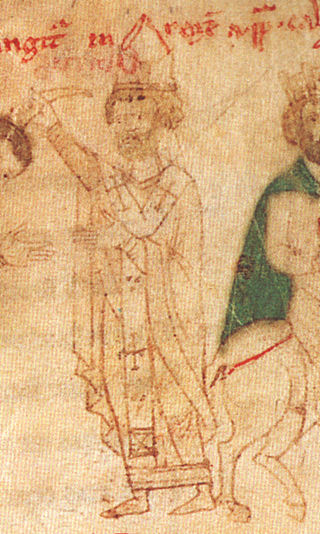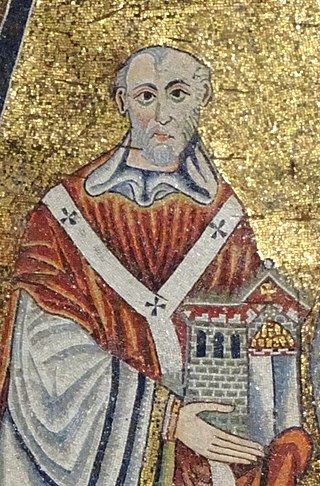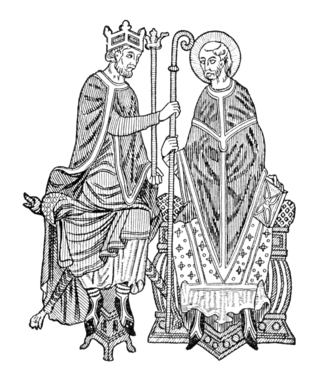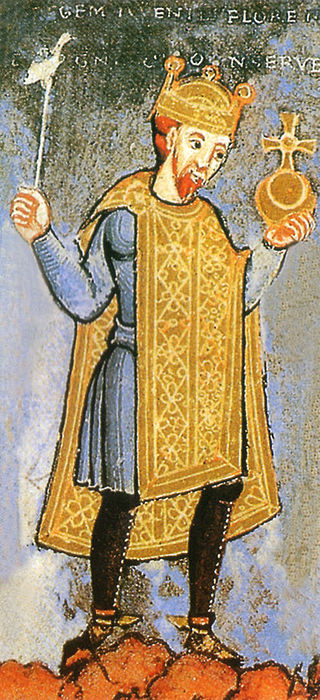
The Concordat of Worms, also referred to as the Pactum Callixtinum or Pactum Calixtinum, was an agreement between the Catholic Church and the Holy Roman Empire which regulated the procedure for the appointment of bishops and abbots in the Empire. Signed on 23 September 1122 in the German city of Worms by Pope Callixtus II and Emperor Henry V, the agreement set an end to the Investiture Controversy, a conflict between state and church over the right to appoint religious office holders that had begun in the middle of the 11th century.
The First Council of the Lateran was the 9th ecumenical council recognised by the Catholic Church. The first ecumenical council to be held in Western Europe & the first since the Great Schism of 1054, it was convoked by Pope Callixtus II in December 1122, immediately after the Concordat of Worms. The council sought to bring an end to the practice of the conferring of ecclesiastical benefices by people who were laymen, free the election of bishops and abbots from secular influence, clarify the separation of spiritual and temporal affairs, re-establish the principle that spiritual authority resides solely in the Church and abolish the claim of the Holy Roman Emperor to influence papal elections.

Pope Alexander III, born Roland, was head of the Catholic Church and ruler of the Papal States from 7 September 1159 until his death in 1181.

Pope Honorius II, born Lamberto Scannabecchi, was head of the Catholic Church and ruler of the Papal States from 21 December 1124 to his death in 1130.

Pope Callixtus II or Callistus II, born Guy of Burgundy, was the head of the Catholic Church and ruler of the Papal States from February 1119 to his death in 1124. His pontificate was shaped by the Investiture Controversy, which he was able to settle through the Concordat of Worms in 1122.

Pope Urban II, otherwise known as Odo of Châtillon or Otho de Lagery, was the head of the Catholic Church and ruler of the Papal States from 12 March 1088 to his death. He is best known for convening the Council of Clermont which ignited the series of Christian military expeditions known as the Crusades.

Pope Victor III, was the head of the Catholic Church and ruler of the Papal States from 24 May 1086 to his death. He was the successor of Pope Gregory VII, yet his pontificate is far less notable than his time as Desiderius, the great abbot of Monte Cassino.

Pope Innocent II, born Gregorio Papareschi, was head of the Catholic Church and ruler of the Papal States from 14 February 1130 to his death in 1143. His election as Pope was controversial, and the first eight years of his reign were marked by a struggle for recognition against the supporters of Anacletus II. He reached an understanding with King Lothair III of Germany, who supported him against Anacletus, and whom he crowned as Holy Roman Emperor. Innocent went on to preside over the Second Council of the Lateran.

Pope Gelasius II, born Giovanni Caetani or Giovanni da Gaeta, was head of the Catholic Church and ruler of the Papal States from 24 January 1118 to his death in 1119. A monk of Monte Cassino and chancellor of Pope Paschal II, Caetani was unanimously elected to succeed him. In doing so, he also inherited the conflict with Emperor Henry V over investiture. Gelasius spent a good part of his brief papacy in exile.

The Investiture Controversy or Investiture Contest was a conflict between the Church and the state in medieval Europe over the ability to choose and install bishops (investiture) and abbots of monasteries and the pope himself. A series of popes in the 11th and 12th centuries undercut the power of the Holy Roman Emperor and other European monarchies, and the controversy led to nearly 50 years of conflict.
The Gregorian Reforms were a series of reforms initiated by Pope Gregory VII and the circle he formed in the papal curia, c. 1050–80, which dealt with the moral integrity and independence of the clergy. The reforms are considered to be named after Pope Gregory VII (1073–85), though he personally denied it and claimed his reforms, like his regnal name, honoured Pope Gregory I.

Jordan I, count of Aversa and prince of Capua from 1078 to his death, was the eldest son and successor of Prince Richard I of Capua and Fressenda, a daughter of Tancred of Hauteville and his second wife, also named Fressenda, and the nephew of Robert Guiscard, duke of Apulia, Calabria, and Sicily. He, according to William of Apulia, "equalled in his virtues both the duke and his father."

Bruno di Segni was an Italian Roman Catholic prelate and professed member from the Order of Saint Benedict who served as Bishop of Segni and Abbot of Montecassino. He studied under the Benedictines in Bologna before being appointed a canon of the cathedral chapter of Siena. He was invited to Rome where he became a bishop and counselled four consecutive popes. He served as Abbot of Montecassino but when he criticised Pope Paschal II regarding the Concordat of Ponte Mammolo in 1111 the pope relieved him of his duties as abbot and ordered Bruno to return to his diocese, where he died just over a decade later. Bruno's canonization was celebrated on 5 September 1181 under Pope Lucius III who presided over the celebration in the late bishop's diocese.

The Archdiocese of Benevento is a Latin archdiocese of the Catholic Church. It currently has five suffragan dioceses: the diocese of Ariano Irpino-Lacedonia, the diocese of Avellino, the diocese of Cerreto Sannita-Telese-Sant'Agata de' Goti, the Territorial Abbey of Montevergine, and the archdiocese of Sant'Angelo dei Lombardi-Conza-Nusco-Bisaccia.
Hugh of Die was a French Catholic bishop.
Cuno of Praeneste was a German Cardinal and papal legate, an influential diplomatic figure of the early 12th century, active in France and Germany. He held numerous synods throughout Europe, and excommunicated the Emperor Henry V numerous times, in the struggle over the issue of lay investiture of ecclesiastical offices. He spent six years promoting the acceptance of Thurstan of York as archbishop by King Henry I of England, without making York subject to Canterbury. He was seriously considered for election to the papacy in 1119, which he refused.
Walter or Gualterio of Albano was the cardinal-bishop of the Diocese of Albano in Italy from 1091 to 1101. He served as papal legate to England in May 1095, where he secured the recognition of Pope Urban II by King William II of England. He also brought a pallium, the symbol of an archbishop's authority, to the newly elected Archbishop of Canterbury, Anselm of Canterbury.

The history of the papacy from 1046 to 1216 was marked by conflict between popes and the Holy Roman Emperor, most prominently the Investiture Controversy, a dispute over who— pope or emperor— could appoint bishops within the Empire. Henry IV's Walk to Canossa in 1077 to meet Pope Gregory VII (1073–85), although not dispositive within the context of the larger dispute, has become legendary. Although the emperor renounced any right to lay investiture in the Concordat of Worms (1122), the issue would flare up again.
The Synod of Brixen was a church council held on 15 June 1080 in the episcopal city of Brixen. It was convoked by King Henry IV of Germany at the height of the Investiture Controversy to pass judgement on Pope Gregory VII. The synod issued a decree condemning the pope, demanding his abdication and authorizing his deposition if he refused. The synod also elected his successor, Wibert of Ravenna.
Anastasius was a Roman Catholic Cardinal, and Cardinal-priest of the titulus of S. Clemente in Rome.












